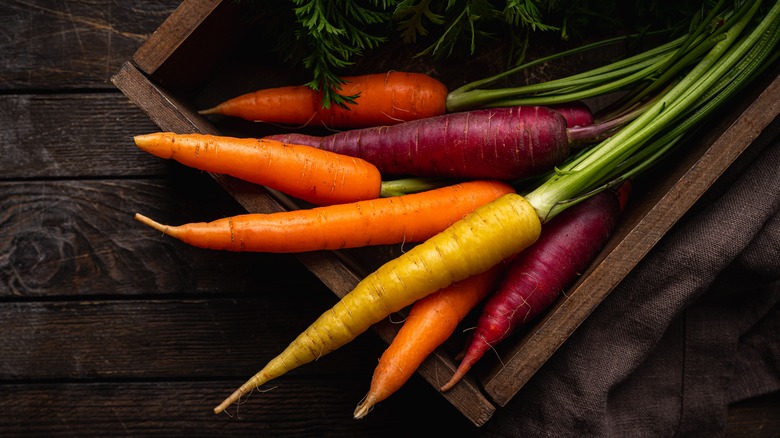The Potentially Royal Roots Of Orange Carrots
Picture a carrot. It's orange, right? Of course. If it's a carrot, it's orange ... or maybe not. Turns out, the most trusted vegetable in the United States, according to a 2022 survey by Bolthouse Farms, wasn't always such a vibrant hue. We know you can find carrots in multiple colors these days, but which color came first? Surprise: It wasn't orange. That hue came way later and, by some accounts, it was conceived as a tribute to a 16th-century war hero. But let's back up a bit.
Researchers tend to agree that the orange carrot we know today was derived over millennia from a wild variety common to the Middle East and North Africa as far back as 5000 years ago, but carrots in ancient times were a far cry from the current-day vegetable consistently ranked among U.S. consumers' favorite produce. Instead, early carrots were pale in color, tough, and had a decidedly bitter taste. Some food historians, including John Stolarczyk, curator of the World Carrot Museum and all-around carrot stalwart, suggest that nomadic traders from North Africa introduced carrots to the Iberian peninsula in the 14th century.
A credible theory, but it casts doubt on a more whimsical story of origin involving a royal member of the House of Orange. According to folklore, orange carrots are a hybrid variety of the root vegetable developed by 16th-century Dutch farmers as a way to honor William, Prince of Orange, for heroic leadership during the Eighty Year's War.
A rainbow of possible carrot colors
World Carrot Museum's Stolarczyk is aware of the legend connecting orange carrots to the House of Orange, but he adamantly insists it's an improbable theory. "Though the development and stabilization of the orange carrot root does appear to date from around that period in the Netherlands, it is unlikely that honoring William of Orange had anything to do with it," he told Live Science in 2020. A letdown, but it doesn't alter the Dutch contribution to the genesis of orange carrots. Stolarczyk concedes that 16th-century Dutch farmers likely developed orange carrots in an effort to create a sweeter variety. The royal connection did happen — eventually. A few centuries later, William's descendants in the House of Orange named orange carrots a royal vegetable.
These days, orange is far and away the most prevalent carrot color, but red, purple, yellow, white, and even black varieties are gaining traction. Often described as having an earthy sweetness, orange carrots bring a full range of versatility to many sweet and savory dishes. They're mainstays in stews and soups, but are equally as good on their own served steamed, roasted, or raw. And don't even get us started on sweet confections like carrot cake. Curious about the colors that preceded orange? Try them; you may like them. A good choice for pickled preparations, purple carrots present a subtle hint of pepper. White carrots present a smooth taste similar to their orange cousins. Raw black carrots are bittersweet, but cooking enhances their sweetness.

